A new species of bioluminescent fungus from the bamboo forests of Meghalaya has been described based on morphological and molecular data. It is the first distributional record of the genus Roridomyces in India. Out of 120,000 species of described fungi, about 100 are known to be bioluminescent or capable of emitting light. Only a few species have been reported from India, mainly due to a lack of studies and documentation. While more research is needed to find out why fungi glow, a study mimicking a large, bright mushroom native to Brazil has shown that they attract insect visitors that could help disperse their spores. The fungal bioluminescent system has been identified and integrated into tobacco plants, which were capable of glowing continuously.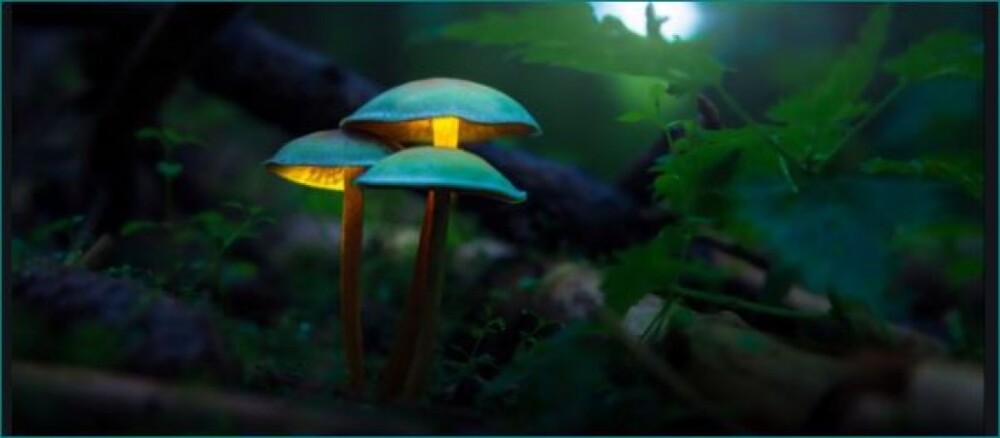
During the monsoon season, a team of scientists from India and China embarked on a fungal foray in Assam. Over the course of two weeks, they were amazed by the vast diversity of fungi in the region: hundreds of species of fungi were spotted, some of which were new to science. After hearing reports from locals of “electric mushrooms”, they headed to West Jaintia Hills District in Meghalaya. It was a drizzly night and a local person guided the team to a bamboo forest, which is part of a community forest, and asked them to switch off their torches. A minute later, the group was awestruck by what they saw: in the midst of the darkness an eerie green glow emerged from dead bamboo sticks that were smothered in tiny mushrooms. The fungus emits its own light—a phenomenon known as bioluminescence.
Interestingly, local residents used the glowing bamboo sticks as natural torches to navigate the forest at night. Steve Axford, a fungal photographer who accompanied the team, set up a small studio and took photos.
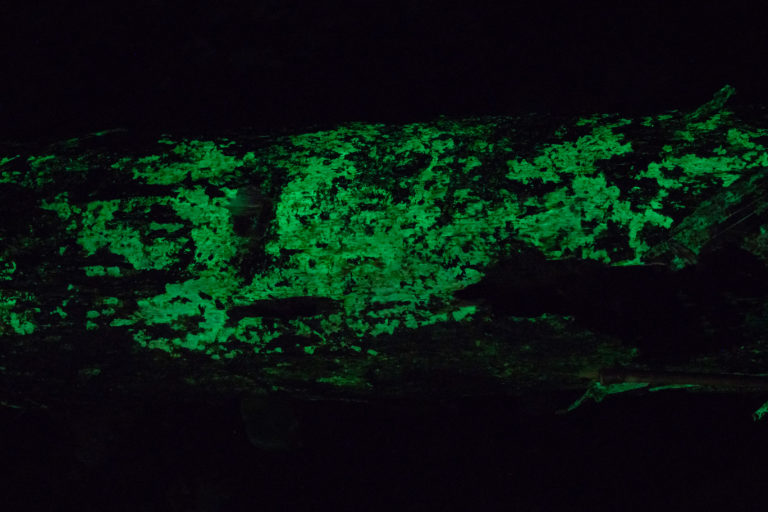
Bioluminescent mycelia on bamboo substrate. Photo by Steve Axford.
Upon closer observation, the team noticed that only the stipes (stalks) of the mushroom lit up and they suspected it could be a new species, said Gautam Baruah, who leads the Rural Futures initiative at the Balipara Foundation in Assam and is a co-author of the report. A detailed examination in the laboratory had confirmed their suspicion: it was a new species from the genus Roridomyces—and the first fungus in this genus to be discovered from India.
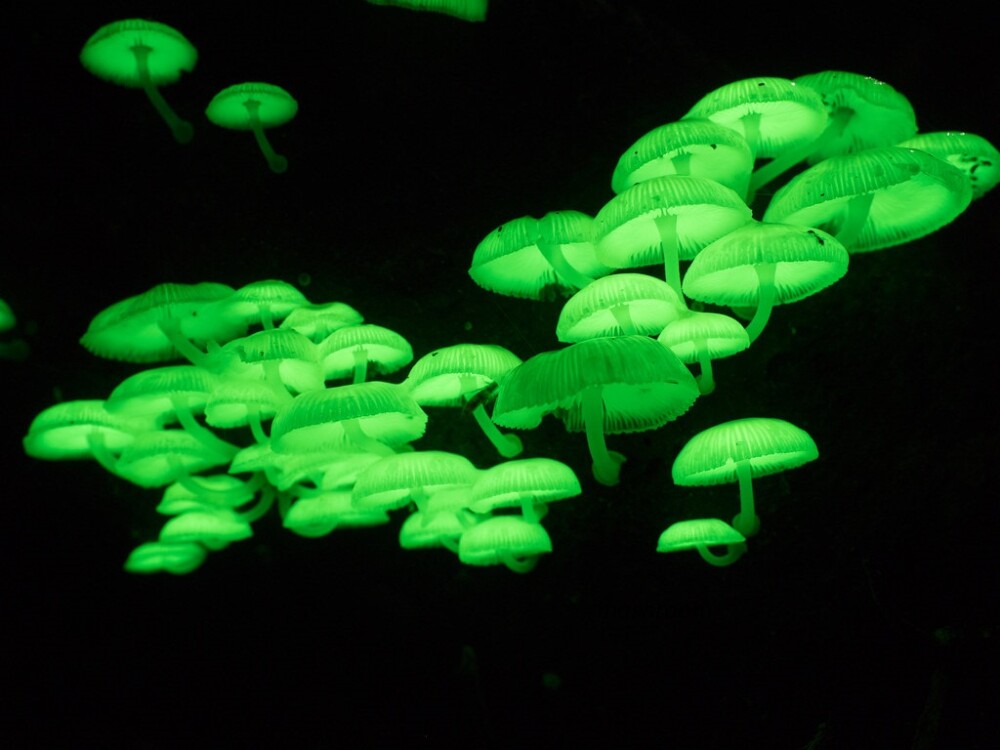
“The members of the genus Roridomyces are very fragile and they love moist and humid conditions,” explained Samantha Karunarathna, senior mycologist at the Chinese Academy of Sciences and lead author of the report. “In general, bioluminescent mushrooms seem to have co-evolved together with some specific insects as these mushrooms attract insects to disperse their spores.”
This mushroom was only found growing on dead bamboo (Phyllostachys mannii). Special elements could be present in the bamboo substrate that this fungus prefers, said Karunarathna, adding that more research is needed to understand why they grow on this bamboo species. So far this mushroom is known from Krang Shuri, West Jayantia Hills District and Mawlynnong, East Khasi Hills District in Meghalaya.
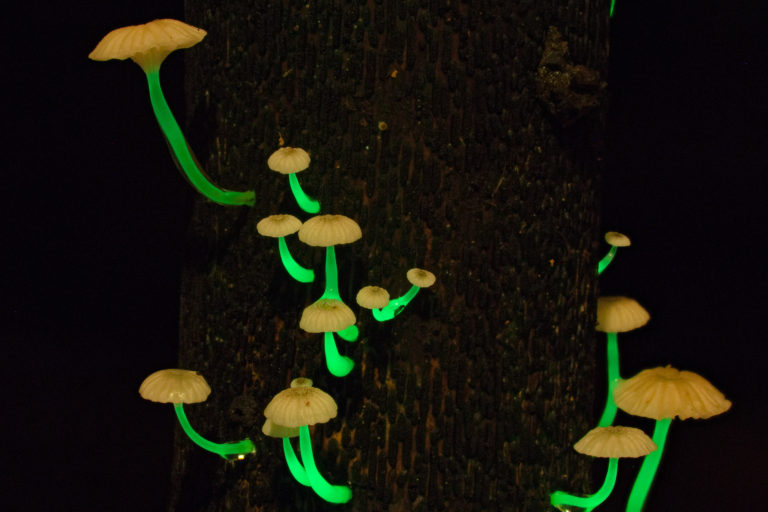
Roridomyces phyllostachydis fruiting bodies. Photo by Steve Axford.
The phenomenon known as bioluminescence or the ability to emit light is more common in animals dwelling in ocean environments than on land. Insects such as fireflies are renowned for their ability to glow but little is known about fungi. The emission of light occurs as a result of a chemical reaction in which the energy is released as light, typically green light.
Senior scientist and head of Jawaharlal Nehru Tropical Botanic Garden & Research Institute (JNTBGRI), C.K. Pradeep hails the finding, stating that fungi in India are not well documented compared with other regions of the world.
“This discovery is thus very important and adds significance in understanding the phytogeographical distribution of bioluminescent fungi and related issues,” he said. “Finding bioluminescent fungi in forests is quite challenging,” he added, “as we have to search for them at night!”
Throwing light on the biogeography of bioluminescent fungi
Of about 120,000 described fungi species (out of an estimated 2.2 to 3.8 million), around 100 are known to be bioluminescent or capable of emitting light. They have been found mainly in temperate and tropical regions in Europe, North and South America, Southeast Asia, Japan, and Australia, among others.
Only a few species of glowing fungi have been reported from India. Two have been reported from the Western Ghats, one in the Eastern Ghats, and one in the state of Kerala, among others. Glowing fungi have also been spotted in the forests of Maharashtra and Goa (part of the Western Ghats) but they have not been scientifically reported. Karunarathna believes the actual number of bioluminescent fungi in India should be higher.
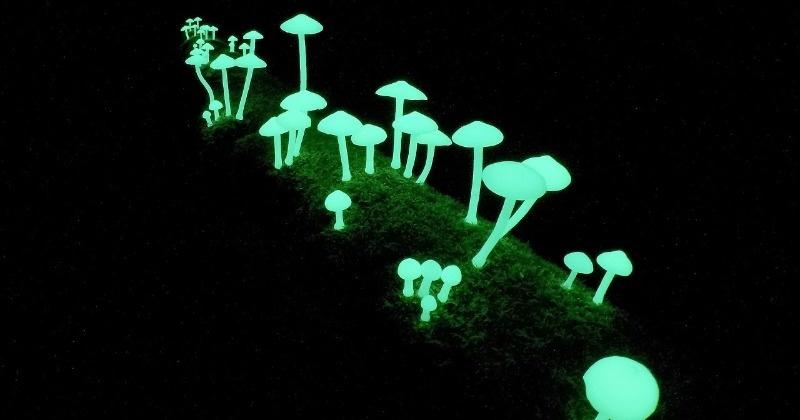
“The vast area in India is also not explored for any group of fungi and in particular macrofungi”, which may have medicinal properties, said Pradeep. “We have so far documented only ca. 1900 species of mushroom-forming fungi from India which is ridiculously small when compared with the area of our country!” A lack of experts and funds are the main obstacles, he explained.
Bioluminescent fungi typically sprout on decaying wood and are capable of digesting lignin in plant debris. Most of the bioluminescent fungi belong to a genus called Mycena (bonnet mushrooms). A recent yet-to-be-peer-reviewed study that sequenced the genomes of five Mycena species, four of which are bioluminescent, showed that bioluminescence evolved in the common ancestor of Mycena and another marasmoid clade and originated around 160 million years ago in the late Jurassic period.
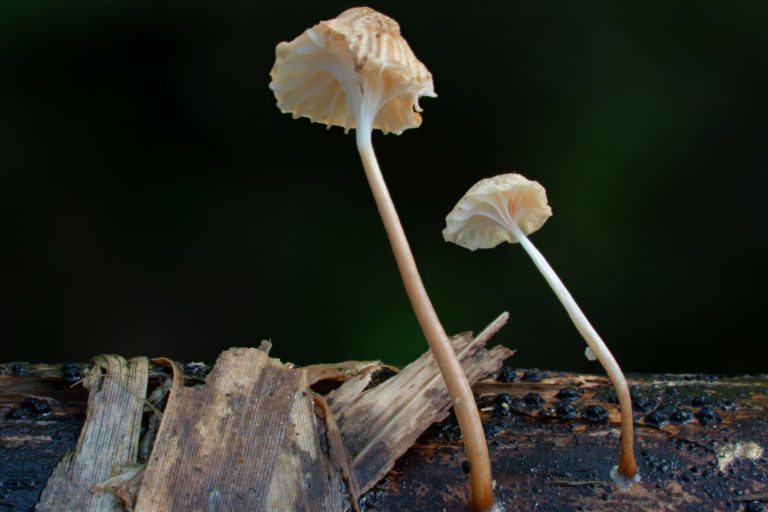
Roridomyces phyllostachydis fruiting bodies during the day. Photo by Steve Axford.Glowing stalks
Karunarathna’s team took fresh fruiting bodies of the fungus and dried them using an electric food dryer. The dried specimens were then brought back to the laboratory where they extracted the DNA and sequenced the internal transcribed spacer (ITS) gene regions and the nuclear ribosomal large subunit (LSU) of the fungus to identify the species. Using the genetic sequences, they built a phylogenetic tree to depict the position of the new species relative to other closely related species.
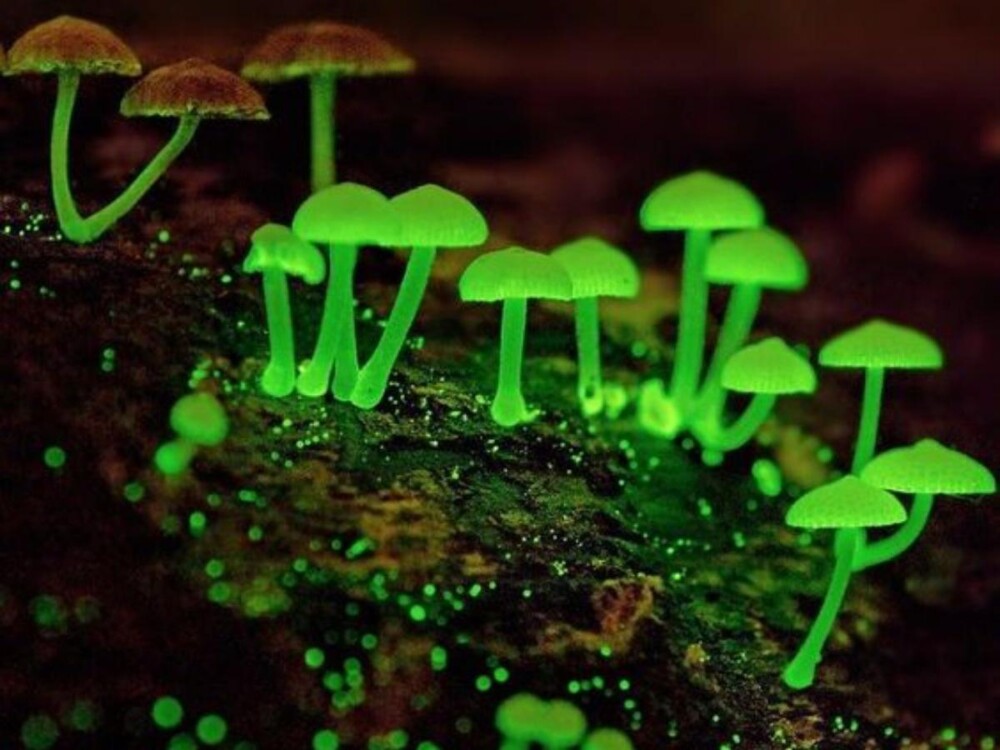
Both the morphological characteristics and phylogenetic analyses showed that the fungus is a novel species from the genus Roridomyces, which presently has 12 species of which five are known to be bioluminescent. In moist conditions, the stipes (stalks) of mushrooms in this genus are slimy or glutinous. This discovery is the first distributional record of the genus Roridomyces in India. The team named the species phyllostachydis, after the genus of the host bamboo tree Phyllostachys from which it was collected.
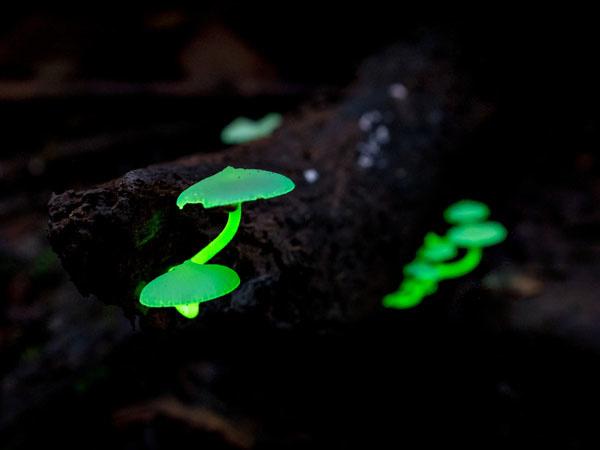
By day the tiny mushrooms, with a cap of around 3 to 15 mm in diameter, look ordinary. But at night they take on an almost spooky avatar with a green glow. What struck the team about this species was that only the stipes and the mycelia (thread-like strands) in the bamboo substrate glowed; the beige caps with a brownish centre did not emit light and the team says the reasons for this are still a mystery. To find out, the team plans to sequence the genome of this mushroom.
Why do fungi glow?
A 2015 study showed that bioluminescence in Neonothopanus gardneri, a large, bright mushroom that grows at the base of young palm trees in Brazilian coconut forests, is under the control of a circadian clock. The activity of the enzymes involved in producing light peaks at night and this regulation implies that the lights serve a purpose.
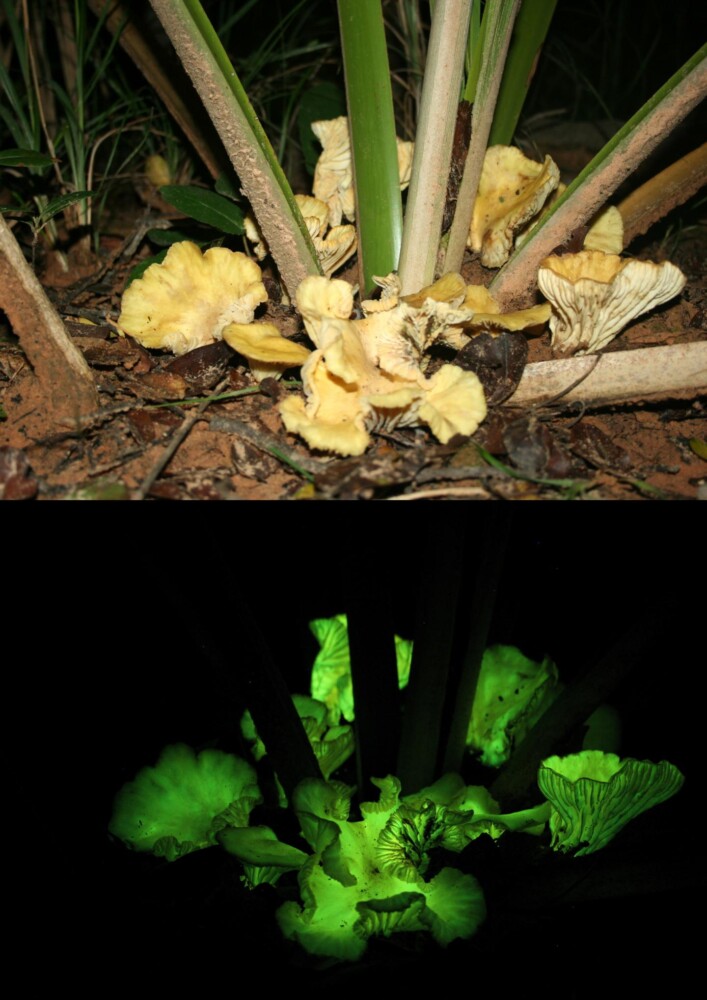
Neonothopanus gardneri mushrooms growing on the base of a young babassu palm in Gilbués, PI, Brazil. Photo by Michele P. Verderane.
Mycologists have been perplexed as to why fungi glow because the process consumes energy. Different species may glow for different reasons depending on the part of the fungus that glows and a couple of hypotheses have been postulated for the ecological role of light: it could be used to attract insects for spore dispersal or to deter frugivorous animals from consuming them. The study on N. gardneri provided evidence of the former.
Researchers built sticky artificial mushrooms made of acrylic resin and fitted them with LED lights inside that emitted a green light equivalent in intensity to N. gardneri. These mimics were then placed in the forest where the real ones are found alongside those without LED lights.
The experiment revealed that more insects such as rove beetles, flies, wasps, and ants were stuck to the lit mushrooms than the dark ones at night. Fungi need help to colonise new substrates and in some cases, the wind can carry and distribute spores. But at the bottom of the forest canopy where N. gardneri is found, winds are generally scarce. The insects in this experiment are capable of dispersing spores and the scientists believe this could be one of the reasons why fungi glow.
Still, it is not known whether the insects aid the mushroom in dispersing its spores and a lot more research is needed to elucidate why fungi emit light.
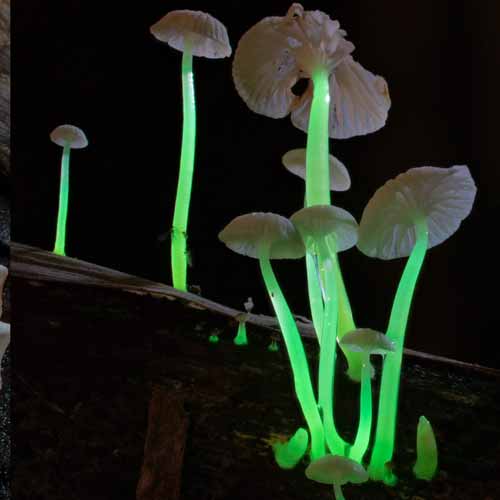
The creation of glowing plants
Scientists have identified four enzymes involved in the fungal bioluminescent pathway: luciferase that catalyzes the oxidation of the compound luciferin, which results in the emission of light, and three other enzymes that are involved in the biosynthesis of luciferin. This pathway could be co-opted in various applications such as in biomedicine, bioengineering and to develop environmental biosensors.
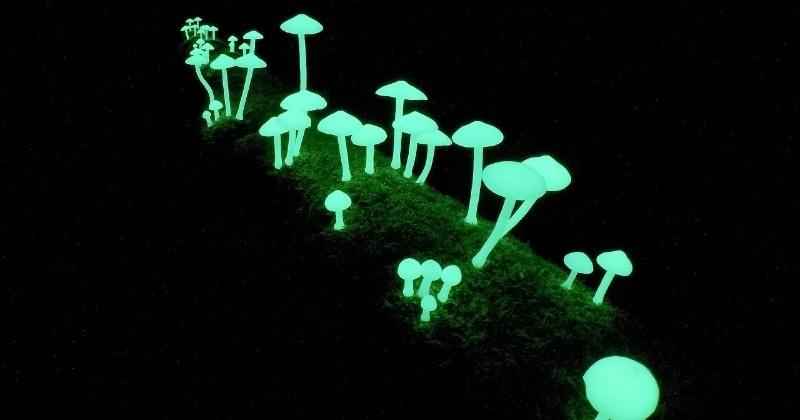
The fungal bioluminescence system could be integrated into plants because the biochemical reactions in some mushrooms are similar to those that naturally occur in plants. In April, a team reported creating engineered tobacco plants with the fungal bioluminescent system and they continuously emitted their own self-sustained light. The plants were also brighter than those created previously using a bacterial luminescence system.
“We did not expect that the experience of seeing the glow in the full-grown plant with the nɑƙeɗ eye would be so magical,” said Karen Sarkisyan of the London Institute of Medical Sciences and senior author of the paper in a statement. These findings could pave the way for real-time monitoring of processes in plants and also the development of glowing plants for various uses such as in organic architecture and street lighting.





